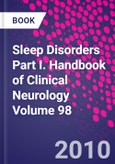Sleep Disorders Part 1 offers a glimpse of developments that focus on diagnostic techniques in the field of neurobiology of sleep. This part discusses the models of the rapid eye movement (REM) sleep mechanism; issues regarding sleep states, stages, and memory consolidation; and advances in the understanding of the sleep-wake genes, gene products, the circadian clock, and the role of sleep duration. This book explains noninvasive neuroimaging studies, particularly positron emission tomographic and single photon emission computed tomographic scans. It further discusses advances in clinical science, including concepts about neurobiology of sleep, narcolepsy-cataplexy, therapy, and laboratory techniques. The significant advances in therapy have led to the addition of new drugs for the treatment of different sleeping disorders, as described in this book. Sleep is essential to humans. Awareness of its true importance leads to the development and acceptance of sleep medicines in the market.
Please Note: This is an On Demand product, delivery may take up to 11 working days after payment has been received.
Table of Contents
Section 1 History of sleep medicine 1. History of sleep medicine
Section 2 Basic science and method 2. Normal sleep-recording and scoring techniques 3. Assessment of daytime sleepiness 4. Actigraphic monitoring of sleep and circadian rhythms 5. Video recordings and video polysomnography 6. Functional neuroimaging in sleep, sleep deprivation, and sleep disorders
Section 3 Basic mechanisms of sleep 7. The phylogeny of sleep 8. Ontogeny of EEG sleep from neonatal through infancy periods 9. Neurobiology of waking and sleeping 10. Neurobiology of REM sleep 11. Neurochemistry of sleep: an overview of animal experimental work 12. Molecular neurobiology of sleep 13. Manifestations and functional implications of sleep homeostasis 14. Thermoregulation in wakefulness and sleep in humans 15. Cytokines in immune function and sleep regulation 16. Endocrine and metabolic changes during sleep 17. Sleep, memory, and molecular neurobiology
Section 4 Clinical aspects of sleep disorders 18. Epidemiology of sleep disorders 19. Cardiovascular and cerebrovascular physiology in sleep 20. Cardiovascular diseases and sleep apnea 21. Alterations in gastrointestinal functioning during sleep 22. Sleep and genitourinary systems: physiology and disorders 23. Sleep enuresis 24. Respiratory physiology in sleep and wakefulness 25. Obstructive sleep apnea: diagnosis, risk factors, and pathophysiology 26. Upper-airway resistance syndrome 27. Central sleep apnea 28. Positive-pressure treatment of obstructive sleep apnea syndrome 29. Medical and surgical treatment of obstructive sleep apnea syndrome, including dental appliances 30. Noninvasive positive ventilation in the treatment of sleep-related breathing disorders 31. Sleep and pulmonary diseases 32. Sleep-associated respiratory disorders and their psychobehavioral consequences in children 33. Sudden death in infants during sleep 34. Neurobiology and the neurological basis of dreaming 35. Abnormal dreams and nightmare disorders 36. Sleep and psychiatric diseases 37. Sleep-related eating disorder 38. Alcohol, toxins, and medications as a cause of sleep dysfunction 39. Sleep, pain, fibromyalgia, and chronic fatigue syndrome 40. Women and sleep 41. Normal and abnormal sleep in the elderly








